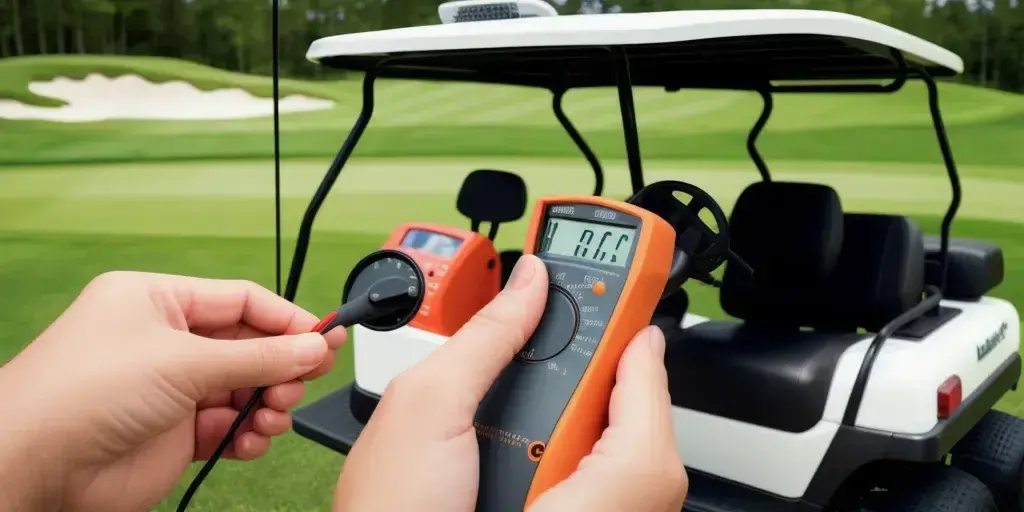
Regular maintenance not only prolongs the life of the cart but also prevents costly repairs and potential safety hazards. Whether you use your golf cart for leisure, work, or transportation within a community, understanding and maintaining its charging system is essential to keep it running smoothly.
What is a Golf Cart Charging System?
A golf cart charging system is the backbone of the cart's electrical functionality, consisting of several key components that work together to power the vehicle. The system primarily includes the charger, batteries, and wiring, each playing a critical role in ensuring the cart has the energy it needs to operate.
When you plug your golf cart into an electrical outlet, the golf cart battery charger converts the AC power from the outlet into DC power, which the batteries store. This stored energy is then used to power the electric motor, lights, and other electrical systems within the cart. Without a properly functioning charging system, the cart would be unable to store energy effectively, leading to diminished performance and potential breakdowns.
Why is Regular Maintenance of the Golf Cart Charging System Crucial?
Regular maintenance of the golf cart charging system is essential for several reasons. First, it helps to ensure that the system operates efficiently, preventing the cart from running out of power unexpectedly. A well-maintained charging system also extends the life of the batteries, which are often the most expensive component to replace.
Neglecting the charging system can lead to a range of issues, from reduced battery capacity to complete system failure. This can result in costly repairs, extended downtime, and, in severe cases, the need for a full replacement of the cart’s electrical components. Additionally, a poorly maintained charging system can pose safety risks, such as electrical fires or battery leaks, making regular inspections and upkeep even more critical.
What Happens if the Charging System Fails?
If the charging system fails, several problems can arise, including:
●Reduced Battery Life: Without proper charging, batteries can degrade faster, leading to frequent replacements.
●Cart Not Running: A failed charging system can leave the golf cart completely inoperable.
●Safety Hazards: Faulty components can cause electrical shorts or battery leaks, posing significant risks.
●Increased Costs: Repairing or replacing a failed system can be expensive, especially if the issue is left unaddressed for too long.
How Does Maintenance Improve the Lifespan of Golf Cart Batteries?
A well-maintained charging system directly contributes to the longevity of the golf cart's batteries. When the system functions properly, it ensures that the batteries are charged efficiently and consistently, which is crucial for their long-term health.
Here are some best practices for extending battery life:
●Regular Cleaning: Keep battery terminals clean and free of corrosion.
●Proper Charging: Avoid overcharging or undercharging the batteries.
●Routine Inspections: Check for any signs of damage or wear in the batteries.
●Temperature Control: Store and charge batteries in a cool, dry place to prevent overheating.
What Are the Key Components of a Golf Cart Charging System?
The golf cart charging system comprises several essential components that work together to keep the cart powered. These include:
●Charger: Converts AC power to DC power to charge the batteries.
●Batteries: Store the energy needed to power the golf cart.
●Wiring and Connections: Deliver power from the charger to the batteries and distribute it throughout the cart.
Charger
The charger is the heart of the charging system, responsible for converting the electrical energy from the outlet into a form that the batteries can store.
There are different types of chargers available:
●Automatic Chargers: These chargers stop automatically when the batteries are fully charged, preventing overcharging.
●Manual Chargers: Require manual shutoff, which can lead to overcharging if not monitored carefully.
Automatic chargers are generally preferred for their ease of use and safety features, while manual chargers offer more control but require careful management.
Batteries
Batteries are the storage units of the golf cart's energy. Maintaining them is crucial for the cart’s performance. The most common types of golf cart batteries include:
●Lead-Acid Batteries: Traditional and widely used, but require regular maintenance, including checking water levels and cleaning terminals.
●Lithium-Ion Batteries: Newer, with a longer lifespan and faster charging times, but more expensive upfront.
Each type of battery has its own maintenance needs, and understanding these is key to ensuring they last as long as possible.
Wiring and Connections
Wiring and connections are often overlooked but are vital to the charging system's efficiency. Poor connections or damaged wiring can lead to energy loss, inefficient charging, or even system failure. Regular inspection and maintenance of these components help ensure that power flows efficiently from the charger to the batteries and throughout the cart.
What Are the Common Issues in a Golf Cart Charging System?
Several common problems can arise within a golf cart charging system, including:
●Faulty Wiring: Can lead to poor power distribution and inefficient charging.
●Malfunctioning Charger: A charger that doesn't work properly can cause overcharging or undercharging of batteries.
●Battery Issues: Old or damaged batteries may not hold a charge as well, reducing the cart's runtime.
How to Identify a Faulty Charger?
Signs that a charger might be failing include:
●Slow Charging: The cart takes longer than usual to charge.
●No Charging: The charger doesn’t turn on or charge the batteries.
●Overheating: The charger gets unusually hot during use.
●Indicator Lights: Flashing or incorrect indicator lights on the charger.
Troubleshooting tips:
●Check the power outlet: Ensure the outlet is working properly.
●Inspect the charger cord: Look for any signs of wear or damage.
●Test the charger: Use a voltmeter to check if the charger is delivering the correct voltage.
What Are the Symptoms of Bad Batteries?
Common symptoms of battery problems include:
●Slow Charging: Batteries take longer to charge than usual.
●Reduced Run Time: The cart doesn’t run as long as it used to on a full charge.
●Corrosion: Visible corrosion on battery terminals.
●Bulging or Leaking: Physical signs of battery damage.
These issues can significantly impact the overall efficiency and performance of the charging system, leading to frequent breakdowns and increased maintenance costs.
How to Perform Routine Maintenance on a Golf Cart Charging System?

Routine maintenance is essential to keep the golf cart charging system in top shape. Here’s a step-by-step guide to maintaining the system:
How to Clean and Inspect the Charger?
●Step 1: Unplug the charger from the power outlet.
●Step 2: Wipe down the exterior with a clean, dry cloth to remove dust and debris.
●Step 3: Inspect the charger for any visible signs of damage, such as frayed cords or cracks.
●Step 4: Plug the charger in and check for proper operation by monitoring the indicator lights or using a voltmeter.
How to Check Battery Health?
●Step 1: Turn off the golf cart and disconnect the batteries.
●Step 2: Check the voltage of each battery using a voltmeter.
●Step 3: Inspect the terminals for corrosion or loose connections.
●Step 4: Clean the terminals with a battery cleaning kit if necessary.
●Step 5: Reconnect the batteries and ensure all connections are secure.
How to Maintain Wiring and Connections?
●Step 1: Turn off the golf cart and disconnect the charger.
●Step 2: Inspect all wiring for signs of wear, fraying, or damage.
●Step 3: Clean any dirty or corroded connections with a wire brush.
●Step 4: Tighten any loose connections to ensure efficient power flow.
●Step 5: Reconnect everything securely and test the system.
What Tools and Supplies Are Needed for Maintenance?
To maintain your golf cart charging system, you’ll need the following tools and supplies:
●Voltmeter: For checking battery voltage and charger output.
●Battery Cleaning Kit: For cleaning battery terminals.
●Wire Brush: To remove corrosion from connections.
●Wrench Set: For tightening battery and wiring connections.
●Protective Gloves and Goggles: For safety during maintenance tasks.
How Often Should Maintenance Be Performed on the Charging System?
Regular maintenance should be performed according to the following schedule:
●Monthly: Check battery water levels (for lead-acid batteries) and inspect wiring.
●Every 3 Months: Clean battery terminals and inspect the charger.
●Every 6 Months: Perform a full inspection of the charging system, including all wiring and connections.
Seasonal Maintenance Tips
Different seasons bring different challenges for golf cart maintenance:
●Winter Storage: Store the cart in a dry, cool place and disconnect the batteries if not in use for an extended period.
●Summer Use: Check the water levels more frequently, as heat can cause more evaporation in lead-acid batteries.
What Are the Benefits of Regular Maintenance?
The benefits of maintaining your golf cart charging system include:
●Improved Performance: A well-maintained system ensures that the cart operates at its best.
●Extended Battery Life: Proper maintenance can significantly extend the lifespan of your batteries.
●Cost Savings: Regular maintenance prevents costly repairs and prolongs the life of the cart.
●Increased Safety: Reducing the risk of electrical fires and other hazards.
How to Troubleshoot Common Charging System Problems?

Here are some common issues and how to solve them:
●Charger Not Turning On: Check the power source, inspect the cord for damage, and test the outlet.
●Slow Charging: Inspect the batteries and charger for any issues, clean connections, and check the voltage output.
●Cart Not Holding Charge: Test each battery’s voltage and check for any dead cells or damaged batteries.
What to Do If the Charger Isn’t Working?
If your charger isn’t functioning:
●Step 1: Test the power outlet and ensure it’s working.
●Step 2: Inspect the charger cord for any damage.
●Step 3: Test the charger’s output with a voltmeter.
●Step 4: If the charger is still not working, it may be time to replace it.
How to Resolve Battery Charging Issues?
If your batteries aren’t charging correctly:
●Step 1: Inspect the batteries for any visible damage.
●Step 2: Check the water levels in lead-acid batteries.
●Step 3: Test the battery voltage with a voltmeter.
●Step 4: If the problem persists, it may be an issue with the charger, not the batteries.
What Are the Signs You Need to Replace Your Golf Cart Charger?
You might need a new charger if:
●Outdated Model: Older chargers may not be as efficient or safe as newer models.
●Frequent Malfunctions: Repeated issues with the charger can indicate it’s nearing the end of its life.
●Visible Damage: Cracks, frayed wires, or other physical damage are signs it’s time for a replacement.
●Inconsistent Charging: If the charger no longer charges the batteries consistently, it may be time for a new one.
How to Choose the Right Replacement Charger?
When selecting a new charger:
●Compatibility: Ensure the charger is compatible with your cart’s battery type and voltage.
●Power Output: Choose a charger with the appropriate power output for your batteries.
●Features: Consider automatic chargers with safety features like overcharge protection.
●Purchase Location: Buy from reputable dealers or manufacturers to ensure quality and reliability.
How to Upgrade Your Golf Cart Charging System?

Upgrading your charging system can provide numerous benefits, including faster charging times, improved efficiency, and longer battery life. Consider the following popular upgrades:
What Are the Best Charger Upgrades?
Advanced charger options include:
●Smart Chargers: Automatically adjust charging based on battery condition, preventing overcharging and extending battery life.
●Fast Chargers: Reduce charging time significantly, ideal for frequent use.
Pros and cons:
●Smart Chargers: Offer greater safety and battery longevity but may be more expensive.
●Fast Chargers: Save time but can generate more heat, which may require careful management.
What Are the Advantages of Lithium-Ion Batteries?
Upgrading to lithium-ion batteries offers several advantages:
●Faster Charging: Lithium-ion batteries charge more quickly than traditional lead-acid batteries.
●Longer Lifespan: These batteries typically last longer, reducing the need for frequent replacements.
●Lightweight: Lithium-ion batteries are lighter, improving the cart’s performance and handling.
●Low Maintenance: They require less maintenance, with no need to check water levels or clean terminals as frequently.
What Are the Safety Considerations for Golf Cart Charging Systems?
Safety is paramount when dealing with electrical components. Here are key safety practices:
●Avoid Overcharging: Overcharging can damage batteries and pose a fire risk.
●Handle Batteries Properly: Always wear protective gear when working with batteries to avoid acid burns or electrical shock.
●Proper Ventilation: Charge batteries in a well-ventilated area to prevent the buildup of flammable gases.
●Inspect Regularly: Regularly check for any signs of damage or wear that could pose a risk.
How to Safely Charge Your Golf Cart?
Follow these steps to safely charge your golf cart:
●Step 1: Ensure the charger and cart are in a dry, well-ventilated area.
●Step 2: Plug the charger into the outlet first, then connect it to the cart.
●Step 3: Monitor the charging process to ensure everything is functioning properly.
●Step 4: Once fully charged, disconnect the charger from the cart before unplugging it from the outlet.
What Are the Dangers of Neglecting Maintenance?
Failing to maintain the charging system can lead to:
●Battery Leaks: Acid leaks from batteries can cause corrosion and pose serious health risks.
●Electrical Fires: Faulty wiring or overcharging can lead to fires.
●Expensive Repairs: Neglecting maintenance often results in costly repairs or replacements.
●Reduced Cart Lifespan: Poor maintenance shortens the overall lifespan of the cart.
Regular maintenance of your golf cart’s charging system is vital for ensuring its longevity, safety, and optimal performance. By following the guidelines and tips provided, you can keep your charging system in top condition, extend the life of your batteries, and avoid costly repairs. Whether you’re an occasional user or rely on your golf cart daily, taking the time to maintain its charging system will pay off in the long run, providing you with a reliable and efficient vehicle for years to come.